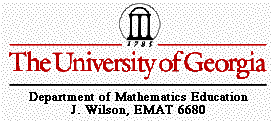

EMAT 8990
by
Doug Westmoreland
The Miquel Theorem

figure1
In 1838, Miquel explicitly stated and proved the following:
In figure 1 above, suppose a point is picked at random on each side of triangle ABC, (points X, Y, and Z). Then in every case, the circles AYZ, CYX, and BXZ are concurrent.
Click here for a GSP sketch of Miquel's Theorem that can be used to examine various points X, Y, and Z.

figure 2
In figure 2, let P be the second point of intersection of the two circles through A and B. Then, cyclic quadrilateral AZPY gives r = s , and cyclic quadrilateral ZBXP gives r = t , making y = z . Thus PZCY is a cyclic quadrilateral.
What if point P doesn't lie inside triangle ABC?

figure 3
AZYP gives r = s on chord AP, ZBXP gives s = t, therefore r = t. Thus, v = 180 - r = 180 - t = u, making quadrilateral PYXC a cyclic quadrilateral.
The theorem remains valid even when X, Y, and Z are selected anywhere on the sides or the extensions of the sides. Click here for a GSP model that allows the points X, Y, and Z go along the extensions of the sides of triangle ABC.
The point P is called the Miquel point of X, Y ,and Z relative to the triangle ABC, and the circles involved are called Miquel circles.
The triangle XYZ is a Miquel triangle of the point P. Investigation: Can there more than one Miquel triangle to a point P? Use the GSP models above to investigate and draw conclusions.
Additional Investigation:
What if points X, Y, and Z are collinear? What happens? Use the last GSP model with extensions of the sides of the triangle to investigate and draw conclusions.
Return to Home Page
Return to Mathematical Gem Page